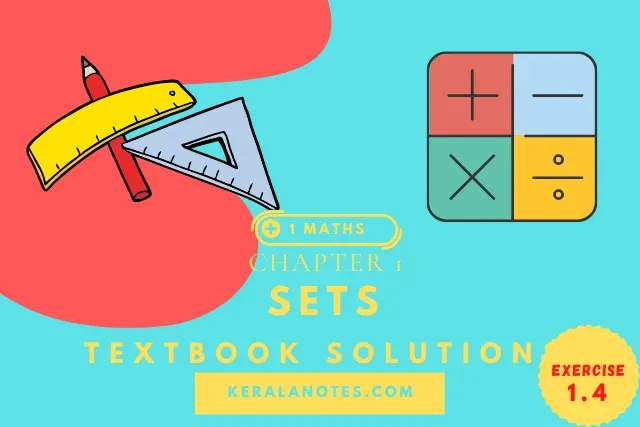| Board | SCERT, Kerala |
| Text Book | NCERT Based |
| Class | Plus One |
| Subject | Math's Textbook Solution |
| Chapter | Chapter 1 |
| Exercise | Ex 1.4 |
| Chapter Name | Sets |
| Category | Plus One Kerala |
Kerala Syllabus Plus One Math's Textbook Solution Chapter 1 Sets Exercises 1.4
Chapter 1 Sets Textbook Solution
- Exercises 1.1
- Exercises 1.2
- Exercises 1.3
- Exercises 1.4
- Exercises 1.5
- Exercises 1.6
- Miscellaneous Exercise Chapter 1
Chapter 1 Sets Exercise 1.4
If X = {a, b, c, d} and Y = {f, b, d, g}, find
(i) X – Y
(ii) Y – X
(iii) X ∩ Y
(i)X-Y={a,c}
Elements present in X but not in Y
(ii)Y-X={f,g}
Elements present in Y but not in X
(iii)X∩Y={b,d}
elements common to X and Y
If R is the set of real numbers and Q is the set of rational numbers, then what is R – Q?
Q is the subset of R.
set of real numbers other than rational numbers are irrational numbers.
R-Q=irrational numbers
State whether each of the following statement is true or false. Justify your answer.
(i) {2, 3, 4, 5} and {3, 6} are disjoint sets.
(ii) {a, e, i, o, u } and {a, b, c, d} are disjoint sets.
(iii) {2, 6, 10, 14} and {3, 7, 11, 15} are disjoint sets.
(iv) {2, 6, 10} and {3, 7, 11} are disjoint sets.
(i) False
As 3 ∈ {2, 3, 4, 5}, 3 ∈ {3, 6}
⇒ {2, 3, 4, 5} ∩ {3, 6} = {3}
(ii) False
As a ∈ {a, e, i, o, u}, a ∈ {a, b, c, d}
⇒ {a, e, i, o, u } ∩ {a, b, c, d} = {a}
(iii) True
As {2, 6, 10, 14} ∩ {3, 7, 11, 15} = Φ
(iv) True
As {2, 6, 10} ∩ {3, 7, 11} = Φ
Find the union of each of the following pairs of sets:
(i) X = {1, 3, 5} Y = {1, 2, 3}
(ii) A = {a, e, i, o, u} B = {a, b, c}
(iii) A = {x: x is a natural number and multiple of 3}
B = {x: x is a natural number less than 6}
(iv) A = {x: x is a natural number and 1 < x ≤ 6}
B = {x: x is a natural number and 6 < x < 10}
(v) A = {1, 2, 3}, B = Φ
(i) X = {1, 3, 5} Y = {1, 2, 3}
X∪ Y= {1, 2, 3, 5}
(ii) A = {a, e, i, o, u} B = {a, b, c}
A∪ B = {a, b, c, e, i, o, u}
(iii) A = {x: x is a natural number and multiple of 3} = {3, 6, 9 …}
As B = {x: x is a natural number less than 6} = {1, 2, 3, 4, 5, 6}
A ∪ B = {1, 2, 4, 5, 3, 6, 9, 12 …}
∴ A ∪ B = {x: x = 1, 2, 4, 5 or a multiple of 3}
(iv) A = {x: x is a natural number and 1 x ≤ 6} = {2, 3, 4, 5, 6}
B = {x: x is a natural number and 6 x
A∪ B = {2, 3, 4, 5, 6, 7, 8, 9}
∴ A∪ B = {x: x ∈ N and 1 x
(v) A = {1, 2, 3}, B = Φ
A∪ B = {1, 2, 3}
Let A = {a, b}, B = {a, b, c}. Is A ⊂ B? What is A ∪ B?
Here, A = {a, b} and B = {a, b, c}
Yes, A ⊂ B.
A∪ B = {a, b, c} = B
If A and B are two sets such that A ⊂ B, then what is A ∪ B?
If A and B are two sets such that A ⊂ B, then A ∪ B = B.
If A = {1, 2, 3, 4}, B = {3, 4, 5, 6}, C = {5, 6, 7, 8} and D = {7, 8, 9, 10}; find
(i) A ∪ B
(ii) A ∪ C
(iii) B ∪ C
(iv) B ∪ D
(v) A ∪ B ∪ C
(vi) A ∪ B ∪ D
(vii) B ∪ C ∪ D
1.{1,2,3,4,5,6}
2.{1,2,3,4,5,6,7,8}
3.{3,4,5,6,7,8}
4.{3,4,5,6,7,8,9,10}
5.{1,2,3,4,5,6,7,8}
6.{1,2,3,4,5,6,7,8,9,10}
7.{3,4,5,6,7,8,9,10}
Find the intersection of each pair of sets:
(i) X = {1, 3, 5} Y = {1, 2, 3}
(ii) A = {a, e, i, o, u} B = {a, b, c}
(iii) A = {x: x is a natural number and multiple of 3}
B = {x: x is a natural number less than 6}
(iv) A = {x: x is a natural number and 1 x ≤ 6}
B = {x: x is a natural number and 6 x
(v) A = {1, 2, 3}, B = Φ
(i) X = {1, 3, 5}, Y = {1, 2, 3}
X ∩ Y = {1, 3}
(ii) A = {a, e, i, o, u}, B = {a, b, c}
A ∩ B = {a}
(iii) A = {x: x is a natural number and multiple of 3} = (3, 6, 9 …}
B = {x: x is a natural number less than 6} = {1, 2, 3, 4, 5}
∴ A ∩ B = {3}
(iv) A = {x: x is a natural number and 1 < x ≤ 6} = {2, 3, 4, 5, 6}
B = {x: x is a natural number and 6 < x < 10} = {7, 8, 9}
A ∩ B = Φ
(v) A = {1, 2, 3}, B = Φ
A ∩ B = Φ
If A = {3, 5, 7, 9, 11}, B = {7, 9, 11, 13}, C = {11, 13, 15} and D = {15, 17}; find
(i) A ∩ B
(ii) B ∩ C
(iii) A ∩ C ∩ D
(iv) A ∩ C
(v) B ∩ D
(vi) A ∩ (B ∪ C)
(vii) A ∩ D
(viii) A ∩ (B ∪ D)
(ix) (A ∩ B) ∩ (B ∪ C)
(x) (A ∪ D) ∩ (B ∪ C)
(i) A ∩ B = {7, 9, 11}
(ii) B ∩ C = {11, 13}
(iii) A ∩ C ∩ D = { A ∩ C} ∩ D = {11} ∩ {15, 17} = Φ
(iv) A ∩ C = {11}
(v) B ∩ D = Φ
(vi) A ∩ (B ∪ C) = (A ∩ B) ∪ (A ∩ C)
= {7, 9, 11} ∪ {11} = {7, 9, 11}
(vii) A ∩ D = Φ
(viii) A ∩ (B ∪ D) = (A ∩ B) ∪ (A ∩ D)
= {7, 9, 11} ∪Φ = {7, 9, 11}
(ix) (A ∩ B) ∩ (B ∪ C) = {7, 9, 11} ∩ {7, 9, 11, 13, 15} = {7, 9, 11}
(x) (A ∪ D) ∩ (B ∪ C) = {3, 5, 7, 9, 11, 15, 17) ∩ {7, 9, 11, 13, 15}
= {7, 9, 11, 15}
If A = {x: x is a natural number}, B ={x: x is an even natural number}
C = {x: x is an odd natural number} and D = {x: x is a prime number}, find
(i) A ∩ B
(ii) A ∩ C
(iii) A ∩ D
(iv) B ∩ C
(v) B ∩ D
(vi) C ∩ D
A = {x: x is a natural number} = {1, 2, 3, 4, 5 …}
B ={x: x is an even natural number} = {2, 4, 6, 8 …}
C = {x: x is an odd natural number} = {1, 3, 5, 7, 9 …}
D = {x: x is a prime number} = {2, 3, 5, 7 …}
(i) A ∩B = {x: x is a even natural number} = B
(ii) A ∩ C = {x: x is an odd natural number} = C
(iii) A ∩ D = {x: x is a prime number} = D
(iv) B ∩ C = Φ
(v) B ∩ D = {2}
(vi) C ∩ D = {x: x is odd prime number}
Which of the following pairs of sets are disjoint
(i) {1, 2, 3, 4} and {x: x is a natural number and 4 ≤ x ≤ 6}
(ii) {a, e, i, o, u}and {c, d, e, f}
(iii) {x: x is an even integer} and {x: x is an odd integer}
(i) {1, 2, 3, 4}
{x: x is a natural number and 4 ≤ x ≤ 6} = {4, 5, 6}
Now, {1, 2, 3, 4} ∩ {4, 5, 6} = {4}
Therefore, this pair of sets is not disjoint.
(ii) {a, e, i, o, u} ∩ (c, d, e, f} = {e}
Therefore, {a, e, i, o, u} and (c, d, e, f} are not disjoint.
(iii) {x: x is an even integer} ∩ {x: x is an odd integer} = Φ
Therefore, this pair of sets is disjoint.
If A = {3, 6, 9, 12, 15, 18, 21}, B = {4, 8, 12, 16, 20},
C = {2, 4, 6, 8, 10, 12, 14, 16}, D = {5, 10, 15, 20}; find
(i) A – B
(ii) A – C
(iii) A – D
(iv) B – A
(v) C – A
(vi) D – A
(vii) B – C
(viii) B – D
(ix) C – B
(x) D – B
(xi) C – D
(xii) D – C
(i)A-B={3,6,9,15,18,21}
Elements present in A,but not in B
(ii)A-C={3,9,15,18,21}
Elements present in A but not in C
(iii)A-D={3,6,9,12,18,21}
Elements present in A but not in D
(iv)B-A={4,8,16,20}
Elements present in B but not in A
(v)C-A={2,4,8,10,14,16}
Elements present in C but not in A
(vi)D-A={5,10,20}
Elements present in D but not in A
(vii)B-C={20}
Elements present in B but not in C
(viii)B-D={4,8,12,16}
Elements present in B but not in D
(ix)C-B={2,6,10,14}
Elements present in C but not in B
(x)D-B={5,10,15}
Elements present in D but not in B
(xi)C-D={2,4,6,8,12,14,16}
Elements present in C but not in D
(xii)D-C={5,15,20}
Elements present in D but not in C
PDF Download
Chapter 1: Sets EX 1.4 Solution
Chapter 1: Sets EX 1.4 Solution- Preview
Plus One Math's Chapter Wise Textbook Solution PDF Download
- Chapter 1: Sets
- Chapter 2: Relations and Functions
- Chapter 3: Trigonometric Functions
- Chapter 4: Principle of Mathematical Induction
- Chapter 5: Complex Numbers and Quadratic Equations
- Chapter 6: Linear Inequalities
- Chapter 7: Permutation and Combinations
- Chapter 8: Binomial Theorem
- Chapter 9: Sequences and Series
- Chapter 10: Straight Lines
- Chapter 11: Conic Sections
- Chapter 12: Introduction to Three Dimensional Geometry
- Chapter 13: Limits and Derivatives
- Chapter 14: Mathematical Reasoning
- Chapter 15: Statistics
- Chapter 16: Probability
Plus One Math's Part I
Plus One Math's Part II
Plus One Maths Related Links
| Plus One Maths Notes | Click Here |
| Plus One Maths Textbook Solutions | Click Here |
| Plus One Focus Area | Click Here |
| Plus One Maths Previous Year Questions with Solution | Click Here |
| Plus One Latest Syllabus | Click Here |
Other Related Links
| Plus One Physics | Click Here |
| Plus One Chemistry | Click Here |
| Plus One Mathematics | Click Here |
| Plus One Botany | Click Here |
| Plus One Zoology | Click Here |
| Plus One Computer Science | Click Here |
| Plus One English | Click Here |






